5 Edible Berry Bushes That Keep on Giving Flavor
Author: Jen Worst | Editor: Omar Alonso
Review & Research: Jen Worst & Chris Miller
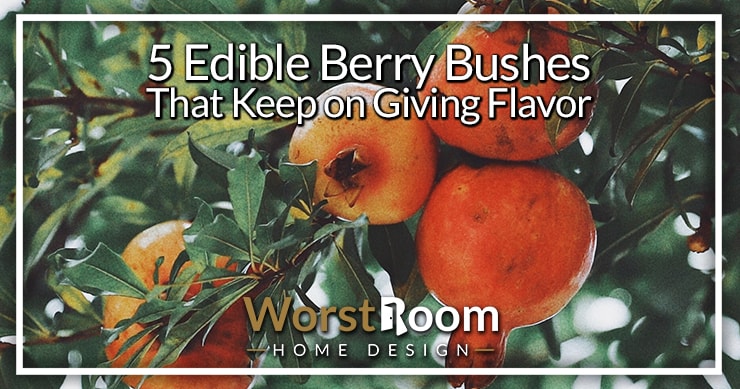
Edible berry bushes are getting increasingly popular in backyards these days. People are looking for fruit-bearing plants that not only look attractive all season but are also easy to grow. We believe that berry bushes fit this description perfectly.
Let's cut to the chase and look at the best five options, ones that are easy to grow, maintain, and produce berry flavors that the most people tend to enjoy.
5 Types of Edible Berry Bushes to Grow
If you want to grow edible berry plants in your backyard and are looking for ideas, here are a few beautiful and easy to grow options for your consideration.
Currants

Currants are much more popular in Europe than they are in the USA. Red currant jelly is a common breakfast item all over Europe. In France, black currants are the main ingredient of cordial Cassis.
There are three types of currants—white, red, and black currants. No matter what type you grow, you can grow it quickly. Currant plants need little to no pruning and grow well in any decent backyard soil.
You only need to give them a few shovels of compost once every year, preferably in spring, and mulch them from time to time to avoid weed invasion. If you live in a colder region with lots of shades, white and red currants are the best for you.
White currants are the sweetest, so if you have a sweet tooth, you should go for those. As for black currants, they're great if you don't have time to maintain your plants as they don't need much care. However, if you prune them in winter, they tend to bear extra fruits later.
With a single currant plant, you can get enough fruit for all your family members. You can eat currants fresh, use them in sauces, or even make jams from them.
Gooseberries
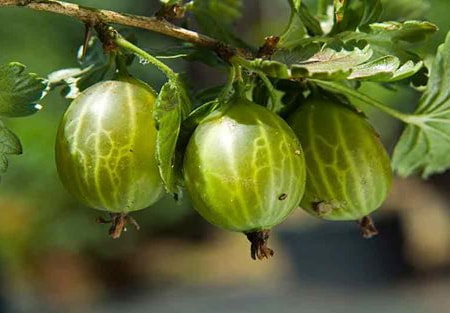
Gooseberries are one of the most versatile types of edible berries out there. You can use them in a number of ways, such as in meat dishes, jellies, many types of jam, and other desserts. However, they are a favorite for pies. Additionally, you can eat them fresh as well.
Even if you neglect your gooseberry plants, they'll produce the right amount of fruit. But of course, if you want maximum fruit out of them, make sure you feed, prune, and—most importantly—mulch them regularly.
That being said, if you're in the USA, you should know that the cultivation of gooseberries and currants is restricted in many regions of the country. This is because they have a role in causing white pine blister rust, which has lethal effects on white pine trees that are important for various purposes.
Fortunately, you can now find varieties of gooseberry and currant plants that are resistant to white pine blister rust. Many states have even lifted the restriction from cultivating gooseberries and currants. So before planting either one of these, check the situation of your city.
Elderberries
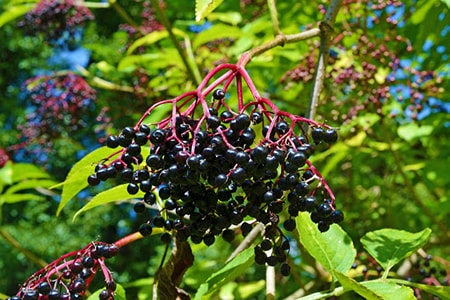
Elderberries are probably the least popular berries, so much so that most people don't even know that they are edible. Many people also see them as food for birds. Thankfully, people are starting to notice them now.
Elderberries are starting to get the recognition they deserve because of their health benefits and fantastic flavor. Elderberries are so easy to grow that they can even thrive amazingly in the wild. These edible berry bushes are so tolerant that they can endure poor soil and even excess of water.
The primary requirements of elderberry plants are proper watering, partial shade, and mulching. Because elderberries have shallow roots, they are always prone to weed attack. Also, for the same reason, they can't tolerate drought and need a regular water supply.
The fruits of these edible berry bushes are used mainly to make wine and are very aromatic in the various types of wine glasses, but many people also use them to make teas, jams, jellies, flavored vinegar, and pies.
The elderberry shrub can grow up to 20 feet in height, but if that's a problem for you, you can regularly prune it to maintain its size. Even when the shrub is not producing fruits, it looks beautiful due to its star-shaped white flowers that soon produce attractive purple elderberries.
Elderberries are found in other colors as well, for example, blue, black, and red. However, purple elderberries are the most common and consumed out of all the types. It would be best if you remembered that red elderberries are poisonous; do not eat or touch them.
Strawberries

Strawberries are the most well-known types of berries out there. If you love strawberries, you'll like them even more after knowing how easy they are to grow and how rewarding they are.
Before rushing out to plant a strawberry bush, it's best to study them and get the right variety. People mostly go for the "June-bearer" or summer-bearing variety that produces one large crop in early summer. This is the best variety if you want maximum fruits to enjoy.
"Ever-bearing" is the second most popular variety; it produces two smaller crops, first in June and then in late summer or early fall. There's a new variety that's referred to as "day-neutral," which produces fruit throughout the season but in smaller amounts.
Unlike some edible berry bushes, strawberry plants don't make you wait long and crop the first summer after planting. When it comes to maintenance, you only need to trim their leaves after fruiting. If it gets cold, it's good to protect the plants by cloches or row covers.
The only drawback to strawberry plants is that they are short-lived. The parent plant produces the most in the first three years, but it gives you three to six offshoots during the growing season.
This calls for additional maintenance. You would need to manage the ratio between parent plants and offshoots to maintain a productive strawberry patch.
Pomegranates
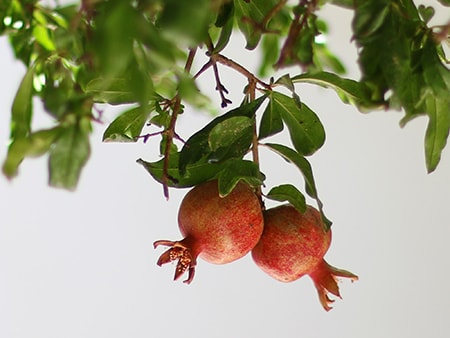
Like elderberry bushes, pomegranate bushes can grow very tall, upwards of 12 to 20 feet. You'll want to prune them unless you intend to let it grow into a bonafide tree.
These grow well in containers and can be taken inside to be protected from the elements in the winter. If treated well they can be made into a large bonsai even and be with you for long periods of your life.
The pomegranate berries themselves grow alongside the new year's growth spurt, so you'll want to prune them in spring to encourage the flowering and fruiting. They perform best in warmer climates with hot summers and more comfortable winters. If you live in colder climates, having a greenhouse can help during the winter tremendously.
If you choose to start from a seed instead of a sproutling, we recommend planting them in containers indoors during the winter so they can have an optimal start. By the time summer rolls around (five to seven months) you can enjoy a few berries.
You should have proper expectations, though. It will take two to three years for the plant to become mature and produce the type of harvest you may be expecting.
At that time, you're ready to add your pomegranates to salads, pies, eaten as is (chilled is my favorite), and even juice them. I'm sure you've seen pomegranate juice at the stores, and now you can make it at home using your preferred types of juicers.
Edible Berry Bush Buying Considerations
Edible berry bushes don't require a much more space than other fruit-bearing bushes or trees. There are several ways you can plant and arrange them in your garden, or even grow them on your patio in containers.
If you have vines, you can train them over arbors or along fences. Some of these bushes can be lined as types of hedges or treated as individual specimen plants. In the case of low growers, you can use your plants as ground covers.
Before buying a berry plant or seeds, you should find out if the type you are going for is self-fruitful or requires cross-pollination to yield berries. In the latter case, you can purchase them in pairs.
You should purchase the varieties that can grow well in your region, too. For instance, if you live in a colder climate, consider buying varieties that thrive in low temperatures. Time your purchase appropriately, since the best time to plant your fruiting berry bushes in early spring.
Most edible berry bushes have beautiful flowers and leaves, not to mention the colorful and vibrant berries. If you're growing them, especially for their fruit, grow several different types to start getting berries from early summer to late fall.
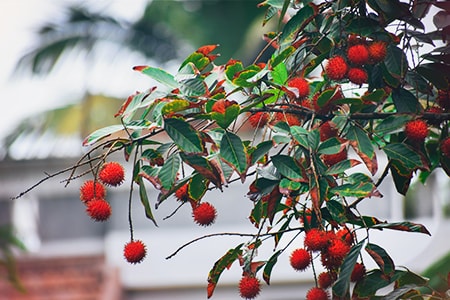
Edible berry bushes don't require a lot of maintenance either. This is mainly because they don't get affected by diseases and pests too frequently.
However, it would help if you still went for plants that have been certified as disease-free so you don't have to deal with viruses that reduce yields and weaken plants. Better safe than sorry or you'll have to learn how to save a dying tree.
Moreover, you don't have to prune your edible berry bushes very often. An annual pruning routine is enough to keep your plants in shape and healthy. Also, most grow finely in regular, well-watered garden soil with lots of sunlight.
That being said, some berry plants have a few particular requirements. If you want to grow them in ideal conditions, the requirements vary from one type of berry to another; even among the types of raspberries it'll vary, for example..
To keep your plants manageable, we recommend growing them in raised beds. The most challenging part of maintenance is to protect your berries from birds, but there are many ways to achieve that. For example, you can pick your berries just before they are ripe.
Add Flavor with Edible Berry Bushes
Although these edible berry bushes are very easy to grow in a garden or backyard, we recommend you do proper research on a plant before buying it. You must remember that while we have just given you ideas to consider, this is not a complete guide on growing the above-mentioned edible berry bushes.
It would be best if you kept in mind several factors before buying a plant, and we surely must have missed many. For example, your soil's pH matters a lot if you want to get the most out of a plant, which you can balance by choosing the right fertilizer numbers.
Also, you need to know what kind of fertilizer you should use for the plant you are going to buy. Other than that, there are many precautions that you need to be aware of. Therefore, make your purchase after fully understanding how to grow the plant of your choice and making sure that you can fulfill its needs.



